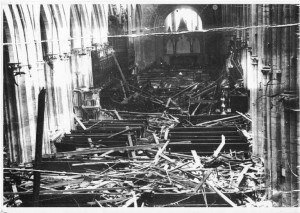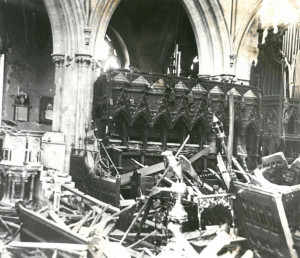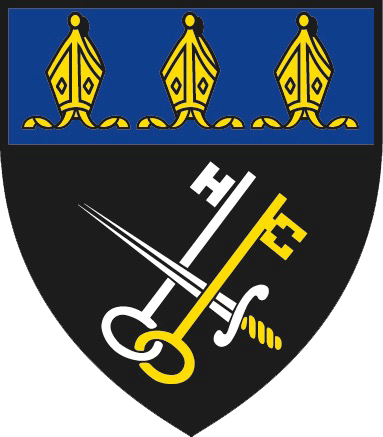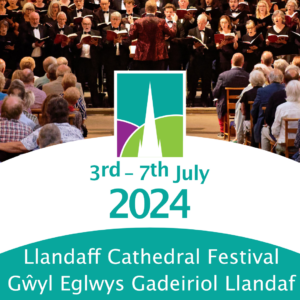Throughout the winter of 1940-41 the German Luftwaffe maintained a ferocious nightly bombing campaign against London and the major towns and cities of Britain. On 2nd January 1941 it was the turn of Cardiff to suffer its heaviest raid of the war, leading to the loss of 165 people, with a further 427 seriously injured.
Early in the raid parachute landmines fell on Llandaff. The parachute of the first one was said to have become entangled with the tip of the spire of the Prichard Tower and then fell into the churchyard on the south side of the cathedral. It exploded, creating a vast crater and destroying many graves, also severely damaging the Chapter House and the roof of the nave, south aisle and chancel.
Much of the roof collapsed inwards, destroying or damaging most of the furnishings including the font, pulpit, choir and canon stalls and the organ. The Rossetti triptych and some of the Victorian stained glass had already been removed to safety and stored elsewhere, but the remainder of the glass was lost, including that in the west windows. Fortunately, fire did not break out.
Immediately after the raid the debris was cleared away and the damaged structure was made safe. The top section of the spire was taken down and the remnants of the roof were demolished.
On the following Sunday worship was held in the Deanery, but this soon moved to the Lady Chapel and the sanctuary, and the repairs of their roofs was undertaken so that as much seating as possible could be provided, but this was not completed until April 1942. This space then served as the cathedral and its services until 1957. No further repair or restoration was possible until after the war had ended in 1945.

Although 1945 marked the end of the war, materials and labour remained restricted to essential building for many years and little progress on the restoration had been made when the Cathedral Architect, Sir Charles Nicholson, died suddenly. The recently installed Dean, Glyn Simon, appointed George Pace as his replacement. Pace was a young architect who was establishing a practice in York, specialising in ecclesiastical architecture. Pace had been recommended to Dean Simon by Eric Milner-White, the Dean of York Minster.
On the advice of Sir Charles, the Dean and Chapter had earlier instructed him to put the cathedral back as it had been, but Pace and Dean Simon adopted a different view. Pace chose to restore earlier work wherever possible but where new work was necessary it was to be frankly of the 20th century but carefully integrated with the existing and this philosophy characterised the whole of the restoration. When Glyn Simon was elected bishop of Swansea and Brecon he was succeeded as Dean by Eryl Thomas who worked equally closely with George Pace and continued the same philosophy.
In addition to repairing that which had survived, the restoration introduced many new features including the coffered timber ceiling to the nave and chancel, the re-ordering of the sanctuary, the Majestas Arch supporting a section of the organ and the Christ in Majesty sculpture by Sir Jacob Epstein and the new memorial chapel for the Welsh Regiment, incorporating the processional way leading to the Prebendal House. The Rossetti painting was not returned to the high altar but was incorporated in a new St Illtyd Chapel at the west end of the north aisle. The lost stained glass was not replaced but instead Pace used natural lighting to great effect throughout.
The restoration was crowned when a great Service of Thanksgiving was attended by the Queen and the Duke of Edinburgh in August 1960, almost twenty years after the bombing and it was to be one of the finest works of the long and distinguished career of George Pace.





